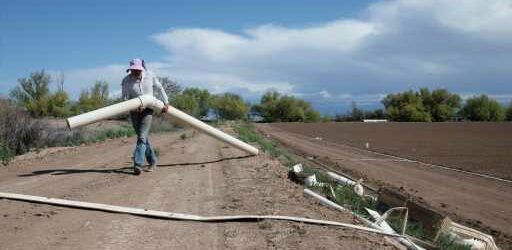One way to save massive amounts of water from the drying Colorado River — state and federal officials had hoped — was to effectively buy water this year from farmers and ranchers with a $125 million conservation program.
But very few are taking the offer. Or those willing to sell were turned away.
“It’s a comical mess,” Shaun Chapoose, chairman of northeast Utah’s Ute Indian Tribe, said. “They ain’t fixing nothing.”
Colorado, New Mexico, Utah and Wyoming, which make up the river’s upper basin, launched the System Conservation Pilot Program late last year, offering money to farmers and others willing to forgo their water use this year, restarting a water-saving initiative that ran just a few years ago.
This time around, though, the program is slated to spend twice as much to save a fifth less water, Colorado River officials say.
Between the four states, 88 applications came in offering to save some water, Chuck Cullom, executive director of the Upper Colorado River Commission, said. The commission approved more than 80% of them.
Federal officials want to save between 2 million and 4 million acre-feet from the Colorado River. An acre-foot is a volumetric measurement of water amounting to about 326,000 gallons or a year’s worth for two average families of four.
Most of those savings must come from Arizona and California, which use the vast majority of the river’s water, more than their allotment. But the System Conservation Pilot Program was meant as a way for upper-basin states to contribute water savings and help prop up sinking water levels at lakes Powell and Mead, the country’s two largest reservoirs.
If each of the program’s approved applications works out as expected the upper-basin can expect to save about 39,000 acre-feet at a cost of about $16 million, Cullom said.
That’s less than 2% of the smallest amount of water federal officials hope to save.
Cullom said the program came together quickly because of dire conditions on the river. That timing made it difficult for farmers to participate. And he said potential participants weren’t clear on how best to apply or what kind of money they could expect in return for their water.
“We need to do better if we do this program again,” Cullom said.
David Harold, a Western Slope farmer, said he wanted to participate but his application was denied. In addition, the state offered him too little for his water and while Harold said he’s willing to pitch in to help the larger Colorado River Basin, he can’t afford to give his water away.
Chapoose said his tribe, which holds a relatively large and senior water right, would have considered applying as well. But based on the language outlining the program, the tribe wasn’t eligible, he said.
The System Conservation Pilot Program
The concept is fairly simple. A farmer, rancher or even a city holds the rights to a certain amount of water that they’re allowed to draw from the Colorado River (or its tributaries) in a given year. The System Conservation Pilot Program had $125 million to dole out, offering them to use less.
A farmer growing corn will use a certain amount of water in a typical year. But if they’re willing to grow barley instead, which might use two-thirds as much water, the state could pay them for the difference they’ve saved. Or they could offer not to grow anything, saving more water and theoretically earning even more money from the program.
Expand that offer throughout each of the four upper-basin states and the hope is that enough people sign up to conserve a substantial amount of water. The more water left in the Colorado River, the higher the levels stay at lakes Powell and Mead, the more water that’s available to generate hydroelectricity, irrigate crops in Arizona and California and flow into major cities like Los Angeles, Las Vegas and Phoenix.
That’s all part of what water officials call demand management: Using incentives — money in this case — to lower the demand for water and keep the basin afloat a while longer. It’s one tool of many in play to conserve water.
Experts have warned that paying people not to use water isn’t a sustainable method, though it can buy the basin some time while the states work to find longer-term solutions.
A similar program ran from 2015 to 2018 and handed out about $8.5 million acre-feet to volunteers, saving less than 50,000 acre-feet.
U.S. Sen. John Hickenlooper served as one of the sponsors for a bill to revive the program this year, anticipating it could save as much as ten times more water as it did the first time around.
Everything came together quickly, Cullom said. Congress authorized the funding for the pilot program in December and the Upper Colorado River Commission had to move quickly to put it into action because the winter forecast looked “dire,” he said. Those who wanted to participate had to apply by March 1.
Out of the gates, that timing put farmers in a difficult position, Gene Shawcroftenvi, chair of the Colorado River Authority of Utah, said. Farmers are an important part of the program because agriculture consumes, by far, the vast majority of Colorado River water.
Farmers need to buy fertilizer, seed and fuel for their equipment far in advance of when they start planting, Shawcroft noted. And by the time the pilot program began accepting applications, many had already made those purchases.
The number of willing participants dwindled immediately, Shawcroft said. And then came the snow, more than almost anybody expected. Farmers who have been suffering extremely dry conditions in recent years can expect more water to grow their crops and many intend to, rather than selling their water rights for the year.
Still others applied, like Harold, who noted that he wanted to participate and pitch in for the overall conservation effort that should help the entire Colorado River Basin. But the commission denied his application, he said.
Harold acknowledges that his application was poorly written, though expectations for the document were unclear. He offered to plant a crop that would need less water than the corn he normally plants and anticipated a certain amount of water savings from the switch.
But the commission disagreed with his math, Harold said. Instead it insisted that the amount of water he’d save from the switch would be lower than he anticipated (thus lowering his potential payment from the program). He said the commission based that decision off his average water use over the last six years.
The last six years have mostly been dry, which would lower that average, Harold noted.
“In the end it just didn’t make any sense for me to participate because it was either not financially viable or it just pissed me off philosophically as well,” Harold said.
He said he’s heard from other farmers who feel the same way or received offers from the program well below what they could have reasonably expected for using less water.
“My proposal to SCPP was honest, fair and thoughtful. I don’t want to screw the system. I’m not out to make this money on the back of everybody else,” Harold said.
If the program is offered again Harold said he’s not sure whether he’ll apply and whether other farmers, like him, will also be put off.
But Harold made it even further in the process than Shaun Chapoose did. He said the program’s rules indicated that Ute Indian Tribe didn’t qualify for the program because their water rights haven’t legally been settled.
Chapoose said his tribe holds the rights to 500,000 acre-feet which pre-date (therefore taking precedence over more junior water rights) most others on the river. The water flowed downstream for years and the tribal chairman said not only has his community never so much as dipped a cup into it but they’ve also never received payment for that resource.
“They just wiped us out of the discussion,” Chapoose said. “They’re still taking it, free of charge. Profiting from it and we’re still left out in the cold.”
Ultimately the Upper Colorado River Commission approved 72 applications, Cullom said. And if each of them move forward as planned they’ll have spent just under 13% of the total federal funding available for the program.
The water savings aren’t as robust as upper-basin officials hoped they would be — they note a similar program for lower-basin states was more successful — but they’re not abandoning the concept yet.
“I don’t think we throw the towel in and say it didn’t work. We learned a lot,” Shawcroft said. “Is it ever going to be something that will produce half a million acre-feet, I don’t know that it will. But we’ll continue to work with it and see what we can do.”
Source: Read Full Article






